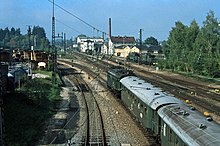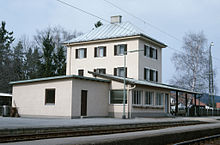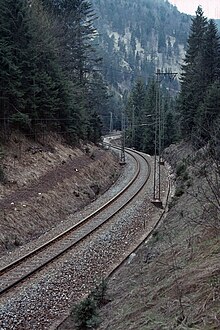Freilassing – Berchtesgaden railway line
| Freilassing – Berchtesgaden | |||||||||||||||||||||||||||||||||||||||||||||||||||||||||||||||||||||||||||||||||||||||||||||||||||||||||||||||||
|---|---|---|---|---|---|---|---|---|---|---|---|---|---|---|---|---|---|---|---|---|---|---|---|---|---|---|---|---|---|---|---|---|---|---|---|---|---|---|---|---|---|---|---|---|---|---|---|---|---|---|---|---|---|---|---|---|---|---|---|---|---|---|---|---|---|---|---|---|---|---|---|---|---|---|---|---|---|---|---|---|---|---|---|---|---|---|---|---|---|---|---|---|---|---|---|---|---|---|---|---|---|---|---|---|---|---|---|---|---|---|---|---|---|
| Route number : | 5740 (Freilassing – Bad Reichenhall) 5741 (Bad Reichenhall – Berchtesgaden) |
||||||||||||||||||||||||||||||||||||||||||||||||||||||||||||||||||||||||||||||||||||||||||||||||||||||||||||||||
| Course book section (DB) : | 954 | ||||||||||||||||||||||||||||||||||||||||||||||||||||||||||||||||||||||||||||||||||||||||||||||||||||||||||||||||
| Route length: | 33.983 km | ||||||||||||||||||||||||||||||||||||||||||||||||||||||||||||||||||||||||||||||||||||||||||||||||||||||||||||||||
| Gauge : | 1435 mm ( standard gauge ) | ||||||||||||||||||||||||||||||||||||||||||||||||||||||||||||||||||||||||||||||||||||||||||||||||||||||||||||||||
| Route class : |
Freilassing – Bad Reichenhall: D4 Bad Reichenhall – Berchtesgaden: CE |
||||||||||||||||||||||||||||||||||||||||||||||||||||||||||||||||||||||||||||||||||||||||||||||||||||||||||||||||
| Power system : | 15 kV 16.7 Hz ~ | ||||||||||||||||||||||||||||||||||||||||||||||||||||||||||||||||||||||||||||||||||||||||||||||||||||||||||||||||
| Maximum slope : | 40.8 ‰ | ||||||||||||||||||||||||||||||||||||||||||||||||||||||||||||||||||||||||||||||||||||||||||||||||||||||||||||||||
| Top speed: |
Freilassing – Bad Reichenhall: 90 km / h Bad Reichenhall – Berchtesgaden: 50 km / h |
||||||||||||||||||||||||||||||||||||||||||||||||||||||||||||||||||||||||||||||||||||||||||||||||||||||||||||||||
|
|||||||||||||||||||||||||||||||||||||||||||||||||||||||||||||||||||||||||||||||||||||||||||||||||||||||||||||||||

The Freilassing-Berchtesgaden railway is electrified and the timetable of the Deutsche Bahn under the timetable route number 954th In Freilassing, the 33.983-kilometer line branches off as a single-track line from the double-track Rosenheim – Salzburg main line . It is classified as a main line to Bad Reichenhall , then as a branch line . The section between Bad Reichenhall-Kirchberg and Hallthurm is considered a steep section with special operational requirements in accordance with Appendix 8 of the steep section regulations of Deutsche Bahn.
History and former sidings
The Freilassing – Bad Reichenhall section was opened in 1866. In 1867 a project for a railway line from Reichenhall to Berchtesgaden was awarded, which was supported by the administration of the Bavarian mining, smelting and salt works. The planning of the Reichenhall – Berchtesgaden section was not completed until 1884. On October 25, 1888, a festively decorated train from Reichenhall to Berchtesgaden was the first to travel the route. The travel time over the entire route was initially 90 minutes and was later reduced to 70 minutes. In 1914 the line was electrified. The power required for this was provided by the Saalach power plant in Kirchberg , which is fed by the dammed Saalachsee and which still supplies traction power today . Electric train operation began in 1916 with specially designed EP 3/6 electric locomotives .
At the curve at the former Gmundbrücke stop on the Tristram Gorge, there was a 70 meter long tunnel until 1933/34; this was removed because four-axle wagons were introduced and the tunnel profile was too small for this.
From 1909 to 1965 there was a connection to the Königsseebahn to Königssee at the end point in Berchtesgaden . From 1908 to 1938, the Berchtesgaden – Hangender Stein railway , also known as the Green Electric , was another connecting line . This in turn had a connection to the Salzburg – Hangender Stein railway , the so-called Red Electric . In the Third Reich , this rail connection was discontinued as part of the planned expansion to the double-track main line and the road expansion. The Watzmannexpress buses have been operating here ever since . The work for the railway expansion began, but was never completed due to the war. Even today, a tunnel without tracks near Berchtesgaden's main train station is a reminder of the unfinished railway project.
vehicles
The operation was opened with local railroad locomotives of the DVIII series . Even glass cases were occasionally used. After electrification, the E 36 01–04 and E 36 21–24 series for mixed service dominated the operation. The series E 70 21–22 and E 79 01–02 were used for freight transport and pushing services to Hallthurm station . After tests with electric locomotives with single-axle drive ( E 73 01-02 ), between the 1930s and their retirement in 1983, the eight machines of the DR series E 44.5 or Deutsche Bundesbahn 144 502-509 provided most of the traction power, they were in the depot Freilassing is located. The 144 502, the only surviving machine from the first series, is erected as a memorial at Freilassing station. 144 508 is in the Lokwelt Freilassing Museum . 144 507 has also been preserved; it is now kept by the Thuringian Railway Friends Association in the former Weimar depot. A wide variety of model series were used for the push service to Hallthurm station, including the E 60 series .
Long-distance transport
With the Intercity - train pair 2082/2083 Koenigssee from Hamburg to Berchtesgaden and back once a day is a direct connection between numerous German cities and the resorts in the Berchtesgaden area. Since the InterCity set is parked in Freilassing at night for logistical reasons, the InterCity car park travels from Freilassing to Berchtesgaden Hbf and from there back to Hamburg in the morning. In the afternoon, the procedure is similar, that is, the train coming from Hamburg runs back to Freilassing immediately after arrival.
Because the four trains mentioned are not run in addition to the regular regional trains on the single-track route, they run instead of the regular trains of the Berchtesgadener Land-Bahn (BLB). So that there are no gaps in the intervals for passengers with local transport tickets, they run on the railway line discussed here as regional express . Despite the regional traffic, the staff is provided by DB Fernverkehr. Another intercity connection with Berchtesgaden, the pair of trains 2428/2429 to the Ruhr area, was discontinued when the timetable changed in December 2007. This service also ran between Freilassing and Berchtesgaden in both directions as a regional train.
Local transport today
S-Bahn Salzburg
The route has been integrated into the Salzburg S-Bahn system since 2006 and is initially used every hour by trains on the S3 line (Salzburg or Golling - Abtenau to Bad Reichenhall) and the superimposed S4 (Freilassing - Berchtesgaden). The train routing for the S3 was extended from the previous final stop in Salzburg main station to Golling-Abtenau. Since then, there have been additional stops next to the main train station in the city of Salzburg. From June 2006 to December 2009 three-part railcar sets of the ÖBB series 4023 and 4024 ("Talent") were used as vehicles. From the 2009 timetable change, the Talent will only operate on the S3 courses between Salzburg and Bad Reichenhall. On the Bavarian part of the S-Bahn line, the trains are run by German staff.
Berchtesgadener LandBahn (BLB)
In October of the same year, a consortium made up of Regentalbahn and Salzburg AG emerged victorious from the invitation to tender for regional train services in summer 2006 . Under the name "Berchtesgadener Land-Bahn" (officially Berchtesgadener LandBahn GmbH , BLB), the company , which was founded on May 4, 2009, took over the traffic for the timetable change on December 13, 2009. Originally, when the route was taken over, the route should be five via Angel Trains Europe leased three-piece railcar of the type FLIRT of Stadler Rail are served; but the passenger traffic approval was granted this new FLIRT railcars by the Federal Railway Authority (EBA) only on 24 and 25 February 2010. Due to the initially not usable own rolling stock was of Freilassing to Bad Reichenhall a Behelfsverkehr with different loaned replacement rolling stock and Bad Reichenhall to Berchtesgaden temporarily set up a rail replacement service with buses. From January 23, 2010, Berchtesgaden was again served by rail. On February 24 and 25, 2010, the missing approvals for the FLIRT were issued by the EBA and operations began. But on the following night on February 26, 2010, four parked FLIRT sets were so badly damaged by vandalism in the Freilassing and Berchtesgaden stations that replacement vehicles had to be used again. The FLIRT trains have been in use on the route since March 1, 2010, and since April 12, 2010, some of them cross-border to Golling an der Salzach .
In a renewed invitation to tender at the end of 2017 together with the Traunstein – Ruhpolding route as the “Chiemgau - Berchtesgaden” network, the Bavarian Oberlandbahn was awarded the contract and will take over the route from the 2021/2022 timetable change. The vehicles from BLB are used.
Freight transport
Significant freight traffic now only takes place between Freilassing and Hammerau . The largest part of the goods volume consists of semi-finished and steel products from the Annahütte steelworks in Hammerau as well as attachment containers for the household waste generated in the district, which are filled at the Hofham alternative junction and loaded onto container wagons for transport to the Burgkirchen waste incineration plant . At the main train stations in Bad Reichenhall and Berchtesgaden there are loading tracks with loading and access ramps; they are used for rail loading of military vehicles from the Bundeswehr locations in Bad Reichenhall and Strub. The siding to the New Saline Bad Reichenhall is no longer used and has also been partially removed from within the Saline, the points were dismantled.
Planning
The political side is specifically considering using the shorter travel times achieved by using modern multiple units for new stops in order to take into account the settlement structure along the route that has changed since the railway was built in the 19th century. The integration into Salzburg's S-Bahn network , which has developed into a regional center since the abolition of the EU internal borders, promotes these efforts. In addition, a large-scale expansion that was on the Austrian side further distance S3 between Freilassing and Salzburg completed already largely: including a third Streckengleis for the S-Bahn and a new Salzachbrücke, additional stops in Mülln, Aiglhof, Taxham and Liefering . A continuation of this work on the German side from the Saalach Bridge, which is also to be newly built (and thus possible more frequent intervals on the KBS 954), began in May 2015.
Stops in the Bad Reichenhall-Mitte and Bad Reichenhall-Nord areas near Staufenbrücke at the level of the District Office are discussed in public . The newly built Freilassing-Hofham stop was put into operation at the end of 2014. On the section to Berchtesgaden, according to the BLB network map, a possible reactivation of the Hallthurm stop is in prospect. Only train crossings are currently carried out in this depot. Due to the difficult, winding route (steep section as well as a large number of slow driving points due to non-technically secured level crossings), travel time reductions on the route from Bad Reichenhall in the direction of Berchtesgaden can only be achieved with considerable technical effort.
literature
- Manfred Angerer, Herbert Birkner: 120 years of Berchtesgaden railway history. ISBN 978-3-925647-54-3 .
Web links
- Website of the Berchtesgadener Land Bahn
- 125 years of the local railway to Berchtesgaden - BR television, broadcast “Schwaben & Altbayern” from October 27, 2013 YouTube video, accessed on May 26, 2015
Individual evidence
- ↑ http://www.eisenbahn-tunnelportale.de/lb/inhalt/tunnelportale/5741.html
- ↑ http://www.eisenbahn-tunnelportale.de/lb/inhalt/tunnelportale/5742.html
- ↑ a b Line network map of the S3 and S4 as of August 2009 ( memento of the original from April 18, 2015 in the Internet Archive ) Info: The archive link was inserted automatically and has not yet been checked. Please check the original and archive link according to the instructions and then remove this notice. (PDF; 216 kB)
- ↑ "Future railway company selected for the Freilassing - Berchtesgaden route": Press release from the Bavarian State Ministry for Economic Affairs, Infrastructure, Transport and Technology
- ↑ Stadler Rail: Info page on BLB FLIRT railcars ( memento of the original from March 8, 2013 in the Internet Archive ) Info: The archive link was inserted automatically and has not yet been checked. Please check the original and archive link according to the instructions and then remove this notice.
- ^ Announcement of January 19, 2010 SU ( Memento of the original of February 23, 2014 in the Internet Archive ) Info: The archive link was inserted automatically and has not yet been checked. Please check the original and archive link according to the instructions and then remove this notice.
- ^ Report in ORF-Salzburg Online about the damage to the trains
- ↑ eisenbahn-magazin 5/2010, p. 24
- ↑ Bayerische Oberlandbahn GmbH was awarded the contract in the “Chiemgau - Berchtesgaden” award procedure. Retrieved December 18, 2018 .
- ↑ Rail transport system of the ZAS - Zweckverband Abfallverwertung Südostbayern ( Memento of the original from October 25, 2008 in the Internet Archive ) Info: The archive link was automatically inserted and not yet checked. Please check the original and archive link according to the instructions and then remove this notice.
- ↑ Start of construction for the 3rd track Freilassing - Salzburg , DB press release of May 11, 2015 ( Memento of the original of June 15, 2016 in the Internet Archive ) Info: The archive link was automatically inserted and not yet checked. Please check the original and archive link according to the instructions and then remove this notice. , accessed June 15, 2016.
- ↑ A new era in local transport has begun , report on heimatzeitung.de from December 16, 2014 , accessed on December 16, 2014









